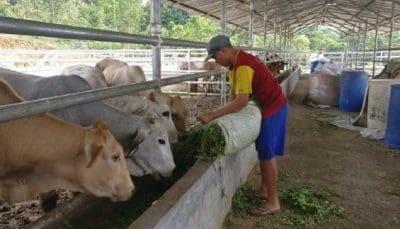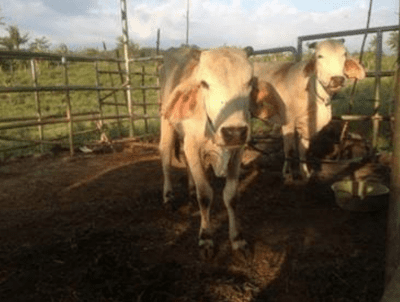RENEWED questions have been raised about the lack of welfare assurances for Australian breeding cattle exported to foreign countries following the release of photographs showing the emaciated condition of Australian cattle in an Indonesian Government breeding program.
The pictures, published by the ABC on Monday, show pictures of Australian cattle that were part of a consignment of 2675 breeders sold through a tender process to the Indonesian Government for Indonesia’s national cattle breeding and beef self-sufficiency program in December 2018.
The cattle were subsequently distributed by the Indonesian Government to cooperatives of smallholders in Java, Kalimantan and Sumatra.
The ABC said pictures it had obtained, which had previously been published in a LiveCorp report to the Australian Government in July of this year, showed Australian cattle that were “malnourished or dead”. The report described some of the pictures as showing “rotting corpses of Australian animals with bones jutting out of their emaciated carcasses”.
The full report made by LiveCorp to Government has not been released publicly, but a six page summary was published on the Department of Agriculture’s website on Friday, after the ABC raised questions about the pictures with LiveCorp and the Federal Government.
The summary report did not include pictures of emaciated cattle but noted that 72 cattle, or three per cent of the entire consignment delivered seven months previously, had died by June 2019.
The Federal Government’s welfare assurance regulatory system ESCAS (Exporter Supply Chain Assurance System) holds Australian exporters legally responsible for the treatment of feeder and slaughter cattle exported to overseas markets through until the point of slaughter.
However the export of breeding livestock sits outside of ESCAS, because of the practical difficulties involved in maintaining effective whole-of-life monitoring of breeding cattle which may live for many years in destination countries before being sold for slaughter.
Australian breeding cattle exported under commercial arrangements can be distributed to networks of smallholders in programs that are directly overseen by importers who are also used to operating under ESCAS rules and manage the line-of-sight issues directly with the local smallholders they support.
The December 2018 shipment documented in the report was exported under a Government to Government contract where the distribution of cattle to smallholders was managed and controlled by the Indonesian Government.
The Australian Livestock Exporters’ Council (ALEC) told Beef Central this morning that the industry wrote collectively to the Federal Government expressing its reticence about the December 2018 tender because of the lack of line of sight over the cattle. At the time it urged the Australian Government to engage industry service provider LiveCorp to monitor the welfare of cattle exported under the program.
LiveCorp was subsequently funded by the Australian Government to develop a project to observe and report on the welfare of the cattle, and to capture learnings to inform future programs. LiveCorp said Indonesian authorities also recognised the potential benefits of the project.
In its summary report LiveCorp said it engaged Indonesian field officers to support the observation of Australian cattle in smallholder cooperatives, who visited approximately 132 cooperatives across Java and Sumatra, which accounted for more than 2,500 head of the exported cattle.
Observations were made on animal housing, access to clean water and feed of sufficient quality and quantity, as well as the knowledge of husbandry and skills of the farmers.
The monitoring and reporting program was funded via two grants from the Department of Agriculture which ran until July 2019, when LiveCorp presented its full report to the Government.
CEO Sam Brown told Beef Central that LiveCorp provided a “full and frank report” to the Department.
He said LiveCorp’s reporting obligations were to provide that report directly to the Government, which it did.
In response to why the summary report published on Friday did not provide pictures of emaciated cattle which were published by the ABC, Mr Brown said the trade program involving the Australian and Indonesian Governments was a diplomatically sensitive issue.
“We provided a full and frank report to the Department and industry.
“We knew that we needed to manage the diplomatic sensitivities in making a public version of it available.
“While our reporting obligations had been completed, we worked with the Federal Government to produce a summary report to communicate the findings in a respectful manner.”
 The LiveCorp summary report said 42 percent of all cooperatives in the program were considered ‘well performing’ as they had no mortalities and no cattle with a body condition score of 1.
The LiveCorp summary report said 42 percent of all cooperatives in the program were considered ‘well performing’ as they had no mortalities and no cattle with a body condition score of 1.
An additional 29 percent of all cooperatives observed had some cattle with low body condition, but no mortalities recorded, and were considered to require some level of support related to cattle nutrition.
Repeat visits demonstrated that the support and information provided by field officers was adopted by the farmers, as the body condition scores of the cattle was observed as improving during subsequent visits.
Approximately 29 percent of cooperatives were considered to be performing poorly, and were found to be experiencing challenges in managing the health and welfare of their cattle.
“Support to increase the skill and capacity of the farmers involved in these cooperatives was prioritised by the project management team. While some had a lack of understanding of good animal husbandry practices coupled with little desire to increase their understanding, others took on the support and information provided and improvements were observed in subsequent visits,” the report said.
The report noted that Indonesia, like Australia, is currently enduring drought conditions. Some farmers involved in the cooperatives also faced the challenges of remoteness, limited access to appropriate feed and water supplies, competing priorities, limited resources (including finances) and limited ability to access regular technical support.
The Department of Agriculture told Beef Central this morning that it does not have a regulatory role once breeder animals arrive in another country.
However a spokesperson said it is working with the Australian industry and Indonesian industry to help improve the management of livestock after they arrive in country.
This included the two grants provided to LiveCorp to monitor and report to industry and Government on the health and welfare of the Australian sourced breeder cattle sent to Java and Sumatra under the 2018 Indonesian Breeder Cattle Import Program, and to support Australian industries to better understand Indonesia’s supply chains for breeder cattle that are imported under the Indonesian Breeder Cattle Import Program.
“In accordance with the requirements of these grants, LiveCorp provided reports to the department. These reports are confidential,” the Department said.
“LiveCorp has prepared a summary report to ensure transparency about the project findings while remaining respectful of the important and valued diplomatic and trading relationship between Australia and Indonesia. (The summary report can be viewed at this link at: https://www.agriculture.gov.au/animal/welfare/breeder-livestock-exports)
“The review looked at the current system and processes. It found ways to improve the welfare of exported breeder livestock. It is important that any response to this issue is done in partnership with Indonesian industry and authorities.
“The department continues to work with the Australian livestock export industry and the Indonesian industry on animal welfare outcomes. Continuous improvement in animal welfare is the responsibility of all countries, including Australia.
“The livestock export industry is a valuable Australian industry that is worth over $800 million each year and supports the livelihood of many people in rural and regional Australia.”
(* Clarification – An initial version of this article reported that the cattle were supplied to the Indonesian Government under ‘a unique Government to Government contract’. The Federal Department of Agriculture has since informed Beef Central that information was not correct. It provided the following statement: “The breeder exports were a commercial tender by the Indonesian government, not a government-to-government arrangement. The Australian government does not sell cattle, nor does the Australian government provide aid in the form of livestock. The cattle were sold by private Australian exporters through the tender process.”)
Australian Livestock Exporters’ Council Chief Executive Officer Mark Harvey-Sutton said it was clear future programs to support Indonesia’s self-sufficiency aspirations will require much stronger support and resourcing by the Australian and Indonesian Governments and industries.
“What we need to do is move toward a concrete agreement between the Australian and Indonesian Governments and industries about managing these consignments in the future.
“There needs to be a direct agreement between the parties – if we do get another request for breeding cattle, we need to have an agreement in place about how it is managed and how it is monitored.”
Mr Harvey-Sutton said the industry has been reviewing protocols surrounding the welfare of Australian breeding cattle in overseas markets and was in the process of drafting a new policy “as we speak”.
However he said no amount of further Australian regulation would solve this specific issue.
“There needs to be agreement and participation by Indonesian industry and Indonesian Government and support from the Australia Government and the Australian industry to develop a framework and an approach that actually does manage the animals while they’re in market.”
‘A horrific reminder of gaping live export loophole’: RSPCA
RSPCA Australia on Monday called for urgent action by the Australian Government to address a loophole in live export regulations, that it says allows the export of animals for breeding and dairy production purposes with no protection in importing countries.
“Yet again, we find ourselves facing another example of the live export industry failing Australian animals,” RSPCA Australia Senior Policy Officer, Dr Jed Goodfellow said.
“Today’s story is just the latest in a long series of disasters, with reports as recently as April this year showing Australian dairy cattle suffering in Sri Lanka.
“How many more incidents like these will it take before the government takes decisive action to protect Aussie animals live exported for breeding purposes? How much more international shame will we allow the live export industry to bring upon our farming sector?
“The Australian Livestock Exporters’ Council said it expressed concerns about the export deal but nevertheless proceeded to supply Australian cattle knowing of the risks. That’s unconscionable.
“It seems they’re willing to sacrifice these cattle to this horrendous fate as the cost of doing business.
“We’ve said it before, and we’ll say it again – there is a loophole in Australia’s live export regulation that you could drive a cattle truck through.
“The Exporter Supply Chain Assurance System (or ESCAS), a system designed by Government to supposedly address the deepening community concern for the welfare of animals sent overseas, does not apply to the tens of thousands of breeding and dairy cattle exported every year.
“The RSPCA has been calling for action to close this gaping loophole since the ESCAS was first introduced in 2011, and yet the system remains unchanged, the Government continues to flounder, and our animals continue to suffer overseas.
“The Minister for Agriculture needs to act to address community concerns and better protect Australian cattle by extending the ESCAS to apply to breeder and dairy cattle.”
The RSPCA also called on the Australian Government to release the full report prepared by LiveCorp into this issue.
“It’s not acceptable to keep the report hidden from the Australian public.
“Community trust in the live export industry is already severely damaged,
“And the more incidents like these that are brought to light, the more it confirms the concerns of Australians – that live exporters only care about profits, and don’t care about animal welfare,” Dr Goodfellow said.




So now the Australian beef industry is responsible for all cattle……..cradle to grave?……….even if they are purchased by foreign governments and mismanaged? Total BS and this narrative should never be pushed by responsible media or beef industry officials.
Would be interesting to know if anyone has looked for the presence of Surra (Trypanosoma evansi) in these emaciated cattle. Australian cattle would be completely naive to this organism.
1.Interesting that the RSPCA , an organisation who has had personnel and officers convicted of the incorrect slaughtering of supposed emaciated cattle , in Australia , want to cast stones in and around other countries .
2. Does anyone really believe that there are not places and properties currently in Australia with the same statistics .
3. Indonesian feedlots have accepted 100,000’s of Australian cattle that would had no where to go in the worst drought ever in 2019 .
Yet the Abc and RSPCA , want to close down a trade that is providing humane feeding operations for Australian stock .
Cut off your nose to spite your face .
I do not have to drive very far here in Australia to see emaciated and dead cattle from the current drought.
Good to know it is only an issue if it happens overseas.
How many drought stricken properties have motality rates under 3%?
Bugger all, considering up to 5% mortality is the generally accepted norm(including all classes of stock) in commercial cattle situations.